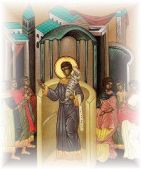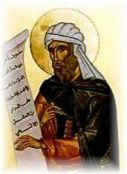Source: St. Andrew Orthodox Church — Riverside, CA
The Church is the pillar of truth in the world spanning history and carrying life to every living body. The Church is the body of Christ and having realized from the very first; that its life is derived from her Master and that it was His love for her sake that made Him sacrifice Himself. So the Church offers to Him gratitude and praise; knowing that her just and everlasting part is to raise her hands in prayer and worship, adoring the Master of life and death, and bowing in submission and humiliation at His feet.
Liturgy or worship is not mere rituals or religious ceremonies of certain forms and orders. Rather, it is a sacramental act accomplished through rituals and practices. God sends us this sacrament from above and allows us to live in His divine presence. Services, in their texts, music, movements, accouterments, and vestments carry a divine truth with a specific spiritual quality. Thereby elevating it from being mere ritual to being a spiritual and just worship. Liturgy is the act, which brings God, the Word of Life to us and makes Him apart of us as a real and holy sustenance. At the same time it is the sublime expression of the Church’s love for and thankfulness to her Master.
Our forefathers, experiencing this divine love, became humble and crushing their hearts shed tears. Thus their minds were enlightened and their hands wrote the most expressive texts which express the experience of man meeting God. Of course, the hymns and praises were a significant part of what they wrote. They used all of God’s gifts to them including knowledge of beauty, communication, and composition of prose, poetry, and music to express who is God and how sweet it is to be with Him. Thus we find that the spiritual hymns and praises occupy an eminent position in the Christian worship since its beginning. “Let the word of Christ dwell in you richly in all wisdom; teaching and admonishing one another in psalms and hymns and spiritual songs, singing with grace in your hearts to the Lord.” Colossians 3:16.
Created in the Fourth century among the Antiochians and using Greek as the language, the Byzantine liturgical system is oriental in its foundation. Established first in Constantinople and then used throughout the whole of the Orient, it is distinguished by beautiful poetic literature, musical richness, powerful doctrinal aspects and immense popularity. Using the Verse and Meter of the Ancient Greek this system produced many types of hymnographical texts for example: The Kathismata, hypakoe, expastelaria, anavathmoi, troparia, kontakia, and canons to name a few.
During the Sixth and Seventh centuries, which combined are considered the second stage of the foundation of Church hymnography, there arose from within the Antiochian Patriarchate many famous composers and chanters. These scholars enriched the Byzantine liturgical system with sound theological texts which when set to various structures and tones and combined with many other church activities developed at that time reveal the large role played by the Church in Antioch in this field.
For this study we will mention only four of the great men of that time: The Chant Sts. Romanos and Cosmas, St. Andrew the Cretan, and St. John of Damascus.
 St. Romanos the Chanter is considered one of the greatest of the chanters. He was born in the last quarter of the Fifth century in Homs, Syria. He became a deacon in the Church of the Resurrection in Beirut, Lebanon and later moved to Constantinople during the time of the emperor Anastasios I (491-518) where he lived in the Monastery of the Virgin. He composed a multitude of hymns and Kontakia using as his resources the Holy Scriptures, Lives to the Saints, current events, and homilies of the fathers of that time. His verses are distinguished by the beauty of their language and style, not only in doctrinal soundness but also in powerful emotion and enthusiasm. Characters in his compositions seem alive and attractive to listeners in a realistic and magnificent way. His most famous hymns are the Christmas Kontakia, and those of Great Monday and Great Friday.
St. Romanos the Chanter is considered one of the greatest of the chanters. He was born in the last quarter of the Fifth century in Homs, Syria. He became a deacon in the Church of the Resurrection in Beirut, Lebanon and later moved to Constantinople during the time of the emperor Anastasios I (491-518) where he lived in the Monastery of the Virgin. He composed a multitude of hymns and Kontakia using as his resources the Holy Scriptures, Lives to the Saints, current events, and homilies of the fathers of that time. His verses are distinguished by the beauty of their language and style, not only in doctrinal soundness but also in powerful emotion and enthusiasm. Characters in his compositions seem alive and attractive to listeners in a realistic and magnificent way. His most famous hymns are the Christmas Kontakia, and those of Great Monday and Great Friday.
 St. Andrew the Cretan was born in Damascus, Syria during the middle of the Seventh century. He was tonsured a monk in Jerusalem and later moved to Constantinople in the year 685. He was ordained the Bishop of Gortina, Crete at the beginning of the Eighth century and died there in 740. He was the creator of the then “new” poetic form known as the Canon. St. Andrew was a great composer of verse; his are many and diverse. Most important of which are the Ideumela of the Einos of Christmas, Annunciation, and the Elevation of the Cross. He also wrote many canons; most notable of which is the Great Canon that consists of 250 troparia about repentance that is chanted on Thursday in the fifth week of Great Lent.
St. Andrew the Cretan was born in Damascus, Syria during the middle of the Seventh century. He was tonsured a monk in Jerusalem and later moved to Constantinople in the year 685. He was ordained the Bishop of Gortina, Crete at the beginning of the Eighth century and died there in 740. He was the creator of the then “new” poetic form known as the Canon. St. Andrew was a great composer of verse; his are many and diverse. Most important of which are the Ideumela of the Einos of Christmas, Annunciation, and the Elevation of the Cross. He also wrote many canons; most notable of which is the Great Canon that consists of 250 troparia about repentance that is chanted on Thursday in the fifth week of Great Lent.
 St. John of Damascus was born there in 650 and his father; Sergios Mansour was the Minister of Tax-Collection for the Caliph Abdulmalik. During his childhood he was educated by the Italian monk scholar Cosmas and learned from him philosophy, theology, and music. After his father’s death, he served the Caliph Al-Waleed briefly. He retired from the world to live as a monk in the Monastery of St. Sabba near Jerusalem. He was ordained a priest for the monastery and later died there in 756. St. John was considered one of the most famous personalities of his time. He made many reforms to church music most important of which were the completion of the Octehos and the adjustment of the eight tones. He wrote many Resurrectioal and Christmas canons as well as the Ideumela for funerals. His compositions are valued for their doctrinal characteristics.
St. John of Damascus was born there in 650 and his father; Sergios Mansour was the Minister of Tax-Collection for the Caliph Abdulmalik. During his childhood he was educated by the Italian monk scholar Cosmas and learned from him philosophy, theology, and music. After his father’s death, he served the Caliph Al-Waleed briefly. He retired from the world to live as a monk in the Monastery of St. Sabba near Jerusalem. He was ordained a priest for the monastery and later died there in 756. St. John was considered one of the most famous personalities of his time. He made many reforms to church music most important of which were the completion of the Octehos and the adjustment of the eight tones. He wrote many Resurrectioal and Christmas canons as well as the Ideumela for funerals. His compositions are valued for their doctrinal characteristics.
 St. Cosmas the Chanter was born in Damascus in 685 and became an orphan early in life. Sergios, the father of St. John of Damascus, adopted the boy and raised him as his own. Along with St. John, St. Cosmas was educated by the Italian monk scholar Cosmas and like his brother became a monk in the Monastery of St. Sabba. He was ordained the Bishop of Mayom, Palestine in 743 and later died peacefully there in 750. Cosmas is famous as a hymnographer and as a chanter. His hymns are composed of topics taken from Holy Scripture and the Lives of the Saints in the same style as that of the writings of the Holy Fathers with simple yet rhythmic verses set to charming tunes. He composed many hymns for various occasions and for different Saints. He was a forerunner in the writing of canons, most notable of which are the canons of Holy Week.
St. Cosmas the Chanter was born in Damascus in 685 and became an orphan early in life. Sergios, the father of St. John of Damascus, adopted the boy and raised him as his own. Along with St. John, St. Cosmas was educated by the Italian monk scholar Cosmas and like his brother became a monk in the Monastery of St. Sabba. He was ordained the Bishop of Mayom, Palestine in 743 and later died peacefully there in 750. Cosmas is famous as a hymnographer and as a chanter. His hymns are composed of topics taken from Holy Scripture and the Lives of the Saints in the same style as that of the writings of the Holy Fathers with simple yet rhythmic verses set to charming tunes. He composed many hymns for various occasions and for different Saints. He was a forerunner in the writing of canons, most notable of which are the canons of Holy Week.
Thus, we see the great role-played by the Church in Antioch during the Sixth and Seventh Centuries by enriching the Byzantine Liturgical System with numerous texts, various hymns and new forms of composition. This was the result of a mixture of Syrian, Greek, and other Oriental elements combined and reflected in a brilliant Rome civilization. If we review the service books used in the Antiochian Rome Orthodox Church as well as those of the other Orthodox Churches of the world who follow the same liturgical system, we find that the texts of the Antiochian Fathers occupy the major part therein. These hymns and praises entered the peoples’ hearts and lives and remained with them in the daily application of the Liturgy of the Church and later became the basic materials for the service books which are still in use to this day.















